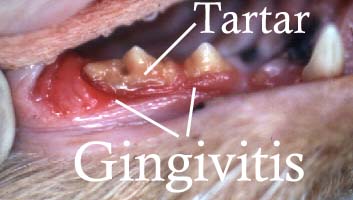 Back
Back
GINGIVITIS IN CATS First broadcast on www.provet.co.uk |
This information is provided by Provet for educational purposes only.
You should seek the advice of your veterinarian if your pet is ill as only he or she can correctly advise on the diagnosis and recommend the treatment that is most appropriate for your pet.
Gingivitis is inflammation of the gums and it is quite a common problem in cats
Gingivitis can easily be recognised in cats as a red line of inflammation - usually running along the margins of the gum with the teeth. Sometimes the tissue is very friable and bleeds easily if touched. Sometimes there are larger ulcerated areas.
Tartar build up on the molar teeth and gingivitis in a cat
The cause of gingivitis is not known. On histological examination the tissue usually has immune cell infiltrates (especially lymphocytes and plasmacytes) so it is thought to be an immune-related disease. Various micro-organisms may be cultured from the mouths of cats with gingivitis - including calicivirus and anaerobic bacteria, but their role in the disease (if any) is unknown.. Blood samples often contain antibodies to bacteria - again suggesting that infections may be important in the cause of gingivitis.
Gingivitis can occur in any cat but it most commonly affects young and middle-aged cats and no specific breeds are affected, although Abyssinian and Somali breeds are reported to have a higher incidence of mild gingivitis (called "red gum" by breeders) than other cats.
Gingivitis is painful, may cause inappetance, and because it can be so sensitive the cats jaw may "chatter" when the nerves are stimulated, such as during eating. Sometimes the gingivitis is associated with erosion of the teeth roots - called "neck" lesions - as well.
There is no satisfactory treatment for gingivitis in cats. Descaling to remove tartar build up and removal of badly eroded teeth is helpful, but the gingivitis will often recur. Antibiotics and anti-inflammatory or immune-suppressive drugs have all be used and may be beneficial in some cases. Feeding special diets formulated to help prevent dental disease, and regular brushing of the teeth with/without pet toothpaste may also be helpful in these cases. Antiseptic mouth washes have been recommended but they are difficult to administer to cats. Surgical removal of the gum margin, cryosurgery and laser therapy have all been used with variable success, and in the most severe cases removal of all the teeth may be undertaken.
Gingivitis can be a frustrating condition to treat - for both veterinarians and owners, but some cases do resolve with periods of remission between relapses.
Updated October 2013
